|
Data
File Updated:
Friday, May 16, 2025
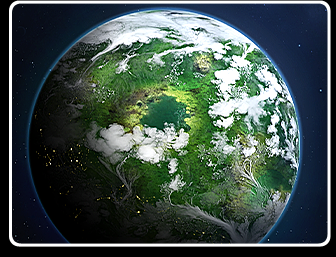 The planet Perrein, second of the three Loroi Sister Worlds, is
surpassed in importance and influence only by the capital of
Deinar. Owing to its complex and ancient (and dangerous) native
biosphere, it is a rich source of foodstuffs, pharmaceuticals
and petrochemicals. Perrein is headquarters to the Mizol caste,
arguably one of the most powerful and influential groups in the
empire. The planet Perrein, second of the three Loroi Sister Worlds, is
surpassed in importance and influence only by the capital of
Deinar. Owing to its complex and ancient (and dangerous) native
biosphere, it is a rich source of foodstuffs, pharmaceuticals
and petrochemicals. Perrein is headquarters to the Mizol caste,
arguably one of the most powerful and influential groups in the
empire.
The Saramalir system is located very near to Deinar. The primary is a G-type star that is
approximately 9 billion years old and nearing the end of its
life. Accordingly the planets in the system have had nearly
twice as long as those in Earth's solar system to evolve and
interact. The current system contains only three major planets;
any others have either been ejected from the system or ripped
apart to join one of the several large debris belts. These belts
are shepherded by the large gas giant, Terron, that dominates the outer
system. The third planet is a sub-Neptune that was unknown to
the Perrein Loroi in pre-spaceflight times, and is referred to
simply as Saramalir III.
The Saramalir system has relatively modest defensive
installations, and no major fleet units have their regular bases
here. Perrein itself has sufficient orbital infrastructure to
handle ordinary planetary traffic and routine ship repair and
upkeep, but there is very little ship construction done here,
the fleet yards of Deinar and Taben being just next door.
Saramalir
I
Perrein is the first planet in the system, and the only
terrestrial world. Its orbit is 257 Earth days, at the inner
edge of its star's biozone, and with a correspondingly hot
climate. The planet spins on its axis once every 26 Earth hours
and has minimal axial tilt and no moons, and experiences very
little seasonal variation during the year. The surface gravity
is about 80% of Earth's. The global climate is very wet, with very
heavy cloud cover and frequent precipitation. The poles are cold
and wet but free of ice. Despite the wet climate, the seas are
relatively small and shallow, most of the water being held in massive
subsurface aquifers.
Tectonic activity ceased when the mantle froze in
the distant past, and in the eons since erosion has flattened
the mountains and silted in the oceans. There is still
scattered geothermal activity from deep hotspots, but this is
mostly limited to geysers and the occasional uplift of
terrain over a swelling hotspot. Most of the terrain consists of
lowland marshes, and a few scattered highland plateaus of
uplifted sedimentary rock. Only a few peaks of ancient harder
rock protrude from a crust that is mostly sedimentary rock,
which is porous and inundated with subsurface water.
The majority of the surface north and south of the equator is
dominated by marsh and vast forests of monstrous scale trees. Emissions
from the forests keep oxygen levels high (similar to Earth's
carboniferous era), and this oxygen enables very active and
sometimes equally monstrous fauna. The canopy of these huge
forests largely obscures the forest floor from
sunlight, with the exceptions of highland plateaus and rocky
outcroppings that rise above the treeline. Within the forests, the
lowland marshes have become a shadow land of bioluminescent
plants and animals in perpetual twilight. Despite the constant
heavy rainfall, most runoff is quickly absorbed into the saline
and acidic underground aquifers. The lack of access to fresh
water and arable land has kept the Loroi population
comparatively small and dispersed for most of the colony's
history.
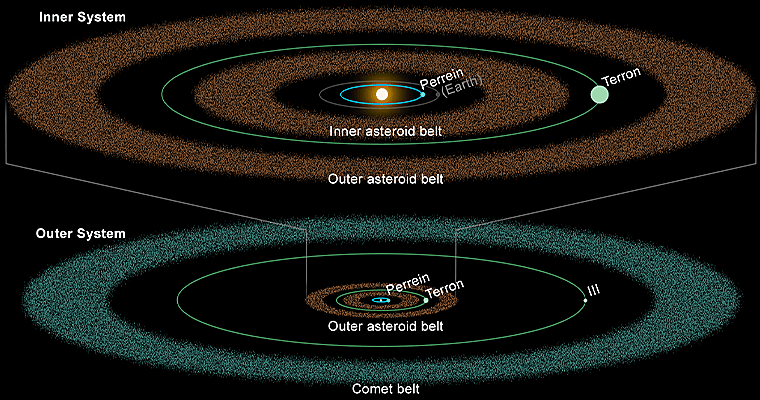
(fig.1: Saramalir
system diagram. Earth orbit included for scale.)
Geologic History
As befits its immense age, Perrein has gone through extreme
shifts in climate over its long history. Current theory suggests
that Perrein was the second of three terrestrial planets, closer in to its sun
than it orbits currently, and was hotter but
had a thicker atmosphere, large deep oceans, and volcanic and
tectonic activity similar to an early Earth. This early epoch
saw the development of native life forms roughly equivalent in
sophistication to our Mesozoic era.
Then, about 5 billion years before the present, it is
believed that there was a close gravitational interaction with
the inner planet. They did not collide, but
the smaller planet was ejected from the system (probably
slingshotted past the sun) and Perrein was flung out into a more
distant orbit. After an initial period of violent earthquakes
and volcanoes, the global temperature dropped precipitously,
resulting in the extinction of most terrestrial species. What
followed was a long epoch of cycles of glaciations and warming
periods that lasted for billions of years. During this era,
the cooling mantle finally froze, halting plate tectonics and
mountain building. Accelerated by the constant freeze and thaw
and scouring of glaciers, over billions of years the mountains
weathered down and the oceans silted up. All the while,
Perrein slowly migrated inward toward its aging sun, possibly
due to interactions with the remaining outer terrestrial planet.
Approximately 1.5 billion years before the present, Perrein's
orbit stabilized in roughly its current location. The beginning
of this epoch is associated with increased meteor activity, so
it seems likely that the neighboring planet had drifted too
close to the gas giant Terron and been torn apart, joining what was
probably the already existing inner debris belt. Though Perrein had been
warming for some time, the cycle of glaciation came
abruptly to an end. The disappearance of the ice sheets led to
an explosive expansion of the equatorial forests, followed by
the radiation of the squidlike sori and their relatives. Thus
began the current geological epoch, which has been remarkably
stable due to the lack of the normal drivers of global
geological change.
Despite the long presence of highly advanced native life
forms, it does not appear that intelligent life ever arose
independently on Perrein (though there is debate over whether
some of the native sori can be considered intelligent). There does
not appear to have been any alien colonization on the planet
prior to the sudden appearance of the Loroi at the time of the Soia Fall,
nor is there known evidence of extensive bombardment
from that time as is common on most other inhabited worlds.
Perrein's
Native Biosphere
Although the biomes on Perrein are fairly homogenous -- the
megaforest canopy, forest floor shadow wetlands, highland
plateaus and
the small polar regions -- the life forms are remarkably sophisticated
and diverse. This is partly due to the extreme age of the
biosphere. Earth has had complex life forms for roughly 500
million years, but Perrein has had similar complexity for ten
times as long, evolving in constant competition. The result has
been a planetwide biosphere of diverse, adaptable and
hypercompetitive organisms.
Perrein organisms tend to have much more genetic information
than a comparable Earth organism, with some having 50 times as
much data as the human genome. This allows for remarkable
adaptability in response to environmental challenges, with an
organism able to shift quickly into a mode that may seem like a
completely different species, and to have separate stages in
life with radically different adaptations to the others. This
adaptability probably arose out of necessity during the planet's
tumultuous shifts in climate, but during the current epoch of
relative environmental stability, Perrein organisms have turned
it to the purpose of ferocious competition for available
resources. It is one of the most dangerous native biospheres in
the Local Bubble, and because of this and the isolated nature of
Loroi settlements on Perrein, there are still many undiscovered
species and unexplored regions.
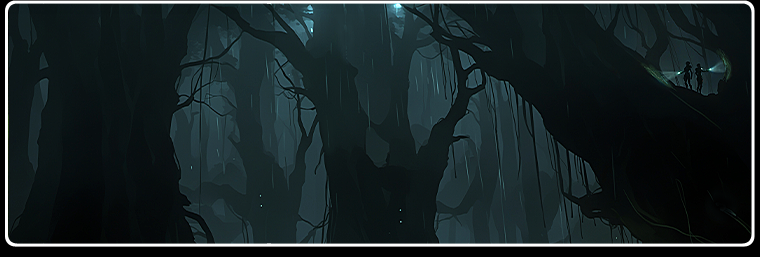
Scale Tree Forests
The enormous scale trees form the foundations of the megaforest biome.
They are named for the distinctive scale patterns of their
latticed trunks, which act as girders to increase structural strength and reduce weight.
These enormous vascular plants can rise more than 200 meters
from the forest floor, and due to the marshy ground and unstable
porous rock of the subsurface, the trees sometimes send roots and
subterranean supports nearly as far below ground as above.
Individual trees can weigh hundreds of tons, and they often
send shoots out to form networks of separate trees which are
still effectively part of the same organism. Although there is
only a modest number of different scale tree species, they have
some of the largest genomes of any organisms on the planet and
so are capable of significant diversity even within a species.
Because of their vast reservoir of genetic material, they can
and do go many generations reproducing asexually without
apparent ill effect, only developing sex apparatus when the
conditions are right.
Some species of scale trees send out lateral branches about
midway up their height to interact with neighboring trees,
forming lattices for stability against collapse. These lattices
can become choked with vines, lichens and detritus from above,
forming a secondary habitat for a variety of organisms. This
microbiome is referred to as the "lower canopy."
The forests dominate nearly every aspect of their ecosystem,
blocking most of the light and regulating temperature and even
weather to some extent. The near constant rain dripping through
the canopy is augmented by a constant drizzle of moisture
aspirated by the trees themselves; some species capture their
own small reservoirs, which can become microbiomes for small
animals seeking fresh water. The mean temperature below the
canopy is much lower than that above and the air pressure tends
to be higher, suffused with fresh oxygen from the trees and
natural gases bubbling from the swamps, generated by animal
activity, decay and the breakdown of carbon-bearing rock.
Shedding of leaves and outer bark layers, in addition to the
breakdown of fallen trees and other dead organisms, continues to build up to add new layers
of sediment to the strata beneath the forest floor.
 Dogos Dogos
Symbiotic with the scale forests is a class of fungoids known
as dogos. The wet soil of the forest floor is honeycombed
with dogos filaments which play an important role in decomposition and
making soil nutrients available to the roots of the scale trees.
Some parasitic varieties grow on the great trunks of the trees
themselves, "helping" to break down and collapse ancient or
sickly trees. Both versions sprout variously-sized above-ground
fruiting bodies, which can be stalked, fan-shaped or dangling
below branches like pendants,
and are often bioluminescent. Most reproduce either through
release of simple spores or more exotic motile offspring
analogous to jellyfish planula. Dogos grow very
aggressively on nearly any carbonaceous food source, and
domesticated varieties (bred to be slightly less toxic) are widely
used as a combination food
source and waste processing aid, especially in Loroi space
facilities. Dogos do not freeze well, so
they must usually be served fresh or else pickled or dried.
Sori
The sori is a broad order of organisms that bear some
resemblance to Earth cephalopods, and which currently dominates the
forest biome on Perrein in a similar way that mammals have
diversified to dominate most Earth biomes. It is currently
thought that the distant ancestors of the sori were parasites on
larger marine animals during the ancient epoch of deep oceans,
and that they grew ever more hardy and adaptable during the long
and difficult period of glaciation cycles as the planet cooled
and tectonic activity ceased. With the rise of the scale tree
forests, sori diversified and radiated to dominate most
ecological niches on the planet, with the exception of flying
creatures and the high-altitude denizens of the highland
plateaus. A few sori utilize membranes to glide or parachute
from the canopy, but none are known to have developed powered
flight.
Sori have widely diverging body plans, from small wormlike
creatures to large tentacled squid-like forms. Most are
amphibious, able to operate in the water, on land or in the
trees; some are very fast swimmers. Nearly all sori must stay
wet, though this is not a problem beneath the forest canopy,
even for species that never directly enter the water. Sori lack internal
skeletons, but their bodies are mostly muscle tissue that is
extremely tough and can become rigid when desired. Many species
can develop hard calcified body parts to serve as claws, beaks
or spines, the latter of which can sometimes be expelled as
projectiles.
A typical sori has a bidirectional alimentary canal with a
mouth at each end. The posterior end of the body ends in an
array of tentacle-like appendages, usually trilaterally
symmetrical. A variable number of small black eyes is arrayed
around the trunk of the body. The anterior end sometimes ends in
a secondary set of appendages, often shorter and more robust,
and often able to be clasped together to form a tough pointed
squid-like mantle. Sori usually swim with an undulating motion
of the posterior tentacles, and climb "upside-down" in the
reverse direction, tentacles first. Some can "walk" on their
splayed tentacles. Some tentacles end in forked tips to aid in
grasping.
Sori are usually pale in color, but many have photophores and chromatophores that can produce bioluminescent
light and/or change color for chameleon-like effects. They lack
centralized brains, but instead have sophisticated decentralized
nervous systems that can perform same functions. It is not
generally believed that any sori have developed what a Loroi
would consider intelligence, but their use of adaptive camouflage
requires significant cognitive ability, and some of the larger sori
predators (such as the didein) can display some very
complex and clever hunting behaviors. Most sori have poor eyesight but
excellent hearing, and some can use effective echolocation.
Sori are almost universally poisonous. Nearly all Perrein
animals contain some kind of toxin, even if it is merely limited
to concentrations of salts and acidic chemicals from the briny
groundwater. Sori, however, take this to another level,
producing a wide variety of sophisticated poisons and
neurotoxins, some of which can be used offensively as venom.
Although sori flesh is frequently used as a food source for
Perrein Loroi, its inherent toxins must first be neutralized
through specially designed preparation processes (usually cooking or pickling).
Most sori utilize some form of parasitism during
reproduction; usually this involves injecting eggs into a live
or freshly dead host. Sori eggs lack shells but are encased in
an envelope of tough muscle tissue that allows the embryo to
very rapidly develop into a larva capable of feeding on its own.
There are many different possible life cycles even for an
individual sori species, which can be switched between depending
on the available hosts. In a situation without a suitable live
host, some sori will inject eggs into their own flesh, using
their own bodies to feed the growing larvae. Sori are
hermaphroditic and have a variety of different strategies for
sexual reproduction; one involves using the "sex partner" as a
host for its parasitic larvae. Most sori are solitary and do not
parent their offspring.
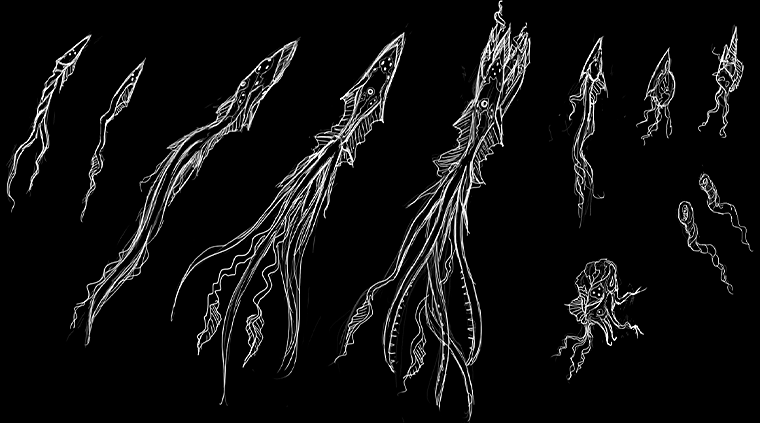
(fig.2: Sori: dizo,
didein, begisas and larvae, beimish. Click for larger image)
Dizo
Dizo are aquatic eel-like sori that feed mostly on planktonic
organisms and
arthropoid larvae in the lakes and lightless underwater caverns.
Dizo were routinely trapped and used as a food source by the
Loroi. Today they are raised in aquatic farms, and pickled dizo
is one of Perrein's largest food exports.
Beimish
Beimish are a variety of small canopy-dwelling sori that sing a bit like frogs, and
are brightly colored and bioluminescent. They are sometimes
used by Perrein Loroi as a combination of music box and night light. However,
they are not fully domesticated and must be kept caged, as they are
venomous and have been known to inject their eggs into their
owners. Beimish light and song performances can be quite complex, and
they have been known to mimic sounds that they hear.
Begisas
Begisas are small hunters of the canopy. In adult form, they
are shaped a bit like long and narrow squid, typically pale with
dark bands, adept at climbing or pursuing prey into narrow
spaces in the tree trunks. Most of their forms are completely
blind, instead relying on superb hearing and smell. They spend much of their lives in
their wormlike "juvenile" form, in which they use their
acute
senses to find and devour burrowed arthropoids. Certain varieties of begisas are among those most commonly bred
and utilized by the Sori Reimadi (see below), including some
that are semi-domesticated.
Didein
One of the deadliest predators of the scale forests, the didein or
"Perrein drone" is a hunter of the lower canopy. It has a long
squid-like body ending in a variable number of tentacles and
a distinctive webbed fringe along its body which is uses as
gills. Large examples can grow to almost three meters in length.
It is an able climber, though it can also swim well if forced to
drop into the water. Its primary weapons are spines that
protrude from the inner face of its tentacles (a bit like
octopus suction cups) which can inject venom. The spines can
detach into the victim, and some species can throw them as
projectiles. The didein has chromatophores which it can use to
create very effective camouflage. Although most sori are
exclusively solitary, the didein has been observed on rare
occasions to hunt in small groups, using auditory and visual
bioluminescent signals to cooperate. Didein can be tenacious
hunters, sometimes pursuing individual prey or days on end, and
have demonstrated the ability to remember individual Loroi. The
didein is named for the barely audible droning sound it makes by
vibrating its gills.
Poilan
A large ambush predator of the forest floor. It burrows
antlion-like traps in the boggy ground in which it waits
half-submerged for unwary prey. The posterior portion which
remains submerged is a characteristic array of sori tentacles,
but the anterior portion mimics other organisms and is used as a
lure for prey. The poilan's genome is one of the largest among
sori, and it keeps extensive libraries of genes tailored to
mimicry of specific prey. The complete animal is a nightmarish
chimera of contrasting body parts, sometimes of more than one
mimic at a time. The poilan's primary weapon is a corrosive goo
which can be squirted up to several meters away, and serves to
encumber, paralyze and break down its prey for digestion.
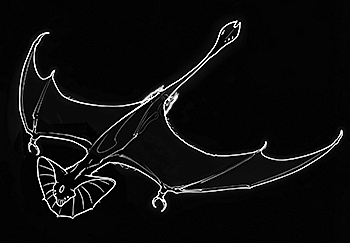 Lobei Lobei
These flying tetrapods are the last surviving major group of
an order of animals that dominated most of the planet prior to the
end of glaciation
epoch. They are warm-blooded and fly with membrane-covered
forelimbs. They mostly dwell in the canopy and feed on small
flying arthropoids. They sport colorful filamentary plumage
which lies close to the skin to help repel water. A few groups
still inhabit the highlands or even the polar regions, being
among the few organisms suited to drier and colder climes. The
forest species hunt primarily by echolocation in the perpetual
dusk; they deploy a large frill around the base of the head
which serves as a sensitive sound receptor.
Terron
The largest terrestrial animals of Perrein are the terron,
six-limbed armored behemoths that feed primarily on scale tree
seedlings. They are only distantly related to the lobei, with characteristics more in common with reptiles, and
have correspondingly less active metabolisms. They are covered in
overlapping armored plates and have a long tail that ends in a
mace-like bludgeon. Terron will also eat the heartwood of mature
trees that have fallen, and they will directly aid in the
collapse of sickly or dead trees. They are slow-moving,
trundling from one treefall site to another, carrying a
miniature biome of matted fungoids on their segmented backs.
Pathogens
Perrein viruses have become expert at manipulating the large
genomes of their host organisms, making them especially
dangerous, especially to bacteria which they are often able to
co-opt and control. However, they are mostly harmless to Loroi
and other alien organisms, as they lack the specific genetic
markers which the viruses are keyed to attack.
Fungal infections are a different matter. Even comparatively
"primitive" fungal organisms on Perrein have more genetic data
than many "higher" animals from other biospheres, making them
highly adaptable and extremely dangerous. There are a variety of
different fungal or bacterial pathogens that can successfully
infect a Loroi (or other alien) host.
Loshradi (Creeper)
One of the deadliest such fungal pathogens is known to the
Loroi as "creeper." It remains fatal if untreated; modern Loroi
medicine can cure infections, but even today at TL10 there is
still no effective vaccination for it. In the era before modern
medicine, it took a heavy toll of the early Loroi settlers -- it
is suggested that it had a significant role in the
near-extinction of the Loroi colony shortly after it was first
established. Perrein-born Loroi descended from those who
survived creeper infections have better odds of surviving an
infection than a
Loroi or other alien from off-world, but terming this "immunity"
would be giving too much credit.
A creeper infection initially causes flu-like symptoms:
lethargy, nausea, and fever. If untreated, the victim's health
deteriorates and she slowly loses higher brain functions,
eventually transforming into a spore-shedding zombie.
Loroi Settlements
At present (c.2160), Perrein is still comparatively sparsely
populated by Loroi. Settlement is divided into numerous
city-states with significant urban and sub-urban populations,
but limited control over the surrounding countryside. The
dangerous native biosphere can be kept at bay by modern urban
countermeasures, but the landscape reverts to a wild condition
only a few meters outside the electrified perimeter. The
countryside is dotted with small homesteads, but these are
largely independent, as little physical infrastructure (such as
roads or plumbing) can be maintained outside the protected urban
perimeter.
Within the forest Shadowlands, traditional housing fashioned of
scale tree wood is usually either located near to the ground and
constructed on stilts to stay clear of the marsh, or else built
directly into the great scale tree trunks themselves. Tree-house
residences are typically situated midway between the forest
floor and the lower canopy for improved safety from hostile
organisms. Lodges for hunting and gathering expeditions are
usually closer to or within the lower canopy, and outposts may
sometimes rise close to the upper canopy itself -- though the
thinning branches at this height limit the practical size of
structures. The biosphere itself often works at breaking down
any such structures, and so maintaining them requires constant
effort and intimate knowledge of the local flora and fauna.
Modern urban housing is constructed with conventional mineral
aggregate and composite building materials, though particular
attention must be paid to foundations and management of the
runoff from near-constant precipitation.
Highland settlements continue to be important if secondary
population centers, as most functions that require access to
open air (such as airports or observatories) must be located
here. Buildings here are much more conventional, though they
must cope with lower atmospheric pressures and much higher
temperatures.
Eishran
The largest current settlement on the planet is the city-state
of Eishran on the coast of the small Remir Sea. Proximity to
open water provides rare (for the Shadowlands) sunlight and sky
access to the coastal portions of the city, and so it is home to
the largest spaceport on the planet and the Imperial administration complex,
serving as the planet's capital.
The Mizol Academy and its associated caste headquarters
buildings are also located here, though deeper into the shaded
portion of the city.
History of the Colony
The arrival of Loroi on Perrein at the end of the Soia era
represents the first evidence of technological settlement at any
time in the planet's history; there are no surviving ruins or
traces of previous civilization. Few traces have survived to the
present of Soia-era technology or artifacts even from the period
after the Loroi arrived. As with the other Splinter Colonies,
the sudden arrival of Loroi is thought to represent refugees
from space fleets or installations making emergency planetfall,
but in the case of Perrein, there doesn't appear to have been
significant infrastructure existing on the planet. There is no
evidence of the extensive bombardment as found on other
inhabited worlds at that time, but the extremely hostile
environment, especially in the absence of supporting
infrastructure, took a deadly toll on the survivors. It is not
known how many Loroi originally took refuge on Perrein, but
genetic studies suggest that shortly afterward the population
was reduced dramatically, perhaps to as few as 100 individuals.
If the Loroi refugees brought any other Soia-liron crops or
livestock with them, very few survived the hostile alien
ecosystem.
The survivors were able to adapt, and the oldest known
settlements first appear not long after planetfall, but these
settlements stayed small and dispersed through much of Perrein's
history. City-states eventually rose, but attempts at empire
were constantly hampered by the environment. The hostile
biosphere kept Loroi populations small and frustrated any
attempts to move large military forces across the landscape.
Conflicts became more about influence than direct warfare, with
cut-throat diplomacy punctuated by small clashes between
long-range guerilla-style pioneer units. Although Perrein
avoided the crippling cycles of overpopulation and destruction
that had arrested development on Deinar, the Perrein settlements
still lost most of their Soia technology almost
immediately, and advancement afterward was slow or sometimes
nonexistent. The Loroi settlers became necessarily occupied with
the constant struggle for survival and learning the ways of the
planet's life forms. The one significant area of advancement was
in telepathic techniques, as a survival tool
against both the native fauna and the
other Loroi.
Forced isolation did allow the various city-states to develop
diverse and distinctive cultures, including at times some
variations that diverged significantly from the usual Loroi
caste-based military oligarchy. Private international mercenary companies were
used as an important supplement to national standing armies. There were
various examples of civilian-run settlements that existed, at least
briefly, without any military oversight. There were even a few
examples of what humans would recognize as formal religions,
very unusual for the Loroi. Dialects of the Trade Language
diverged and developed into fully distinct languages.
Slowly, the city-states and their satellites expanded into the surrounding wilds, with the environment fighting
them every step of the way. Equally slowly, they advanced in
technology. The landscape offered a wealth of natural resources,
from ample fossil fuels to heavy metals to native foodstuffs,
but accessing them was never easy. Eventually Perrein Loroi
crawled their way up to a TL6 post-industrial technology level
(combustion, rockets, radio), but even at its height the
pre-contact global Loroi population never exceeded about 300-400
million -- and they were about to experience a significant
setback.
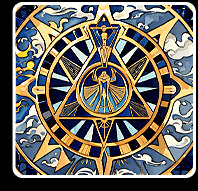 The Sun-Worshippers The Sun-Worshippers
Those Loroi that settled in the highland plateaus had initially
developed the most successful communities, as living above the
forest canopy offered them the most familiar environment with
the most advantages for survival. Even some of the Soia-liron
support organisms such as the grain misesa and smaller
livestock animals including the tirriti had managed to
survive at higher altitudes. However, the settlements remained
isolated and unable to project their influence into the forested
areas, until the shadowlands city-states eventually rose in
power to eclipse them. Many highland nations either became
vassals to the shadowlands city-states or else were destroyed,
to be later re-founded and eventually repeat the same fate.
A few highland cultures survived by isolating themselves even
further, and these included some of the societies that diverged
the most from the Loroi norm. In a few, even the traditional
role of Loroi males evolved. In many Perrein forest societies
the clan names passed through the male rather than the female
line, even though male individuals usually had little authority.
Loroi males on Perrein practiced the usual "philosopher" role as
re-tellers of their heroic mythology, but in a few places, some
male philosophers began to take honorary and then actual
positions as clan heads. There arose a society in which the male
leaders of their spiritual traditions became influential in
actual government. Their rituals began to resemble those of a
formal religion, complete with temples, idols, animal
sacrifices, and a male priesthood. This "religion" waxed and
waned over the millennia with the rise and fall of different
city-states, sometimes spreading to other highland communities
and at other times seeming to almost disappear. It had largely
died out before the Industrial Age, but one of the highland
nations succeeded in resurrecting a modified version of it, in a
sort of way analogous to how the Fascists of the 30's tried to
revive and co-opt the trapping of ancient Rome. This was,
unfortunately, the last chapter of that TL6 global Loroi Perrein
civilization at its height.
The Atomic Wars
Loroi civilization on Perrein collapsed almost back to
pre-industrial levels as the result of a series of wars that included the use
of atomic weapons, the last of which ended roughly 500 years
before reunification with Deinar. This was around the same time,
perhaps ironically, that Deinar was launching its first
satellites. Records from that era are spotty, as little survived
the ensuing chaos. Oral history paints the zealotry of the
highland "sun-worshippers" as a significant factor in the long
cold wars between the city-states suddenly turning hot, even if
it was merely the spark that ignited the flame.
In the aftermath, the Perrein Loroi struggled to recover.
Between the loss of their hard-won technologies and the radioactive
contamination that made some of their most important city-states
uninhabitable, many Loroi settlements became overrun by native
fauna and abandoned, in some cases for generations. The highland
religion finally disappeared for good (except for the occasional
modern facsimile sometimes unearthed by rebellious teenagers).
Technology on Perrein had not even returned to pre-war levels,
and the global population was still less than 200 million Loroi
at the time of contact with Deinar in 850 CE.
Deinar Contact and Reunification
Contact was a bit one-sided and something of a shock to the
Perrein Loroi, with Deinar starships suddenly arriving in orbit
and attempting to communicate. With the discovery of ancient
telepathic amplifiers on Mezan, telepaths on Deinar had detected
the presence of the Perrein Loroi almost 50 years earlier. It
had taken a crash starflight program to allow the Deinar Loroi
to travel the distance and makes themselves known to their
Perrein counterparts. A few Perrein telepaths would later claim
after the fact that they had sensed a presence during the period
in which they were being observed by Deinar farseers, but any
who might have reported this at the time were evidently not
taken seriously.
Loroi language had by this point diverged well past the point
of mutual intelligibility, but fortunately telepathy could
bridge that gap with relative ease. While the Deinar Loroi
initially found Perrein's technological backwardness
disappointing, they soon discovered that when it came to
telepathic techniques, Perrein in many ways surpassed them.
Trade and cultural exchange began almost immediately. However,
despite the modern celebration of 850 CE as the date of
"Reunification," it would be almost 350 years before any formal
political affiliation would exist between the two sister worlds.
In 1199 CE Perrein signed the Axis pact that established a
formal joint government for all Loroi, and in 1402 Perrein
became a part of the modern Imperial system.
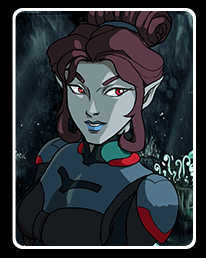 Perrein Culture Perrein Culture
Physically, Perrein Loroi are of
medium height. Those from the sunlit
upland regions have very dark skin, while those from the
jungle-covered shadowlands are ghostly pale and have improved
low-light vision. The Perrein Loroi have
perhaps the strongest spoken tradition among the three Loroi
Sister Worlds, and have
a reputation for being easy to communicate with (if not always
easy to trust). Perrein produces formidable telepaths, and has
the highest occurrence of psychokinetic abilities as a
percentage of any Loroi population, though Perreinid
psychokinetics tend to be of lower power-levels. Although at the time of reunification the population of Perrein
represented nearly a quarter of all Loroi, since then the
population of Perrein has grown the least of the three Sister
worlds, and is still less than half a billion. Large numbers of
Perrein Loroi have moved to more hospitable locations off-world.
The Perrein Loroi have an unusual relationship with time. In
addition to the other stereotypes about the Perrein Loroi, they
have a reputation for an inability to be punctual or to remember
important dates.
The sky can't be seen in most places on Perrein, and so it can
be difficult to tell the time of day much less the date.
Seasonal changes aren't directly noticeable except in the most
extreme latitudes, and so time is marked almost entirely through
cycles in the local biome, which in turn are driven mostly by
movement of the massive underground aquifer, which shifts due to
geological processes and the solar tides. These migrations, spawnings, moltings, etc. are local
phenomena, so each
Perrein city-state has its own set of events which mark the
passage of time, which are largely unfamiliar even to other
Perrein communities.
Perhaps ironically, in the present era the Perrein planetary
clock and calendar are used
as the imperial standard, and most space facilities are run on
Perrein time. This had led to widespread
observance of several Perrein-specific holidays in the wider
Fleet, since they can be easily tracked on the standard calendar as
opposed to holidays specific to other planet-specific calendars.
(The choice of Perrein time as standard was a political
concession of the negotiations during reunification.)
Though clan affiliation was abolished with the establishment
of the imperial system, local city-state loyalties are still
strong elements of the culture. Many local inhabitants identify
more strongly with their city-state than any other affiliation,
and there are still rivalries and covert "hostilities" between
them (mostly non-violent).
Shadowlands Diral
The hostile Perrein biosphere provides a stark and
unforgiving testing ground for students in the traditional Loroi
diral system, in which bands of children are sent on forays into
the wilds. The use of Shadowlands diral has become iconic
especially for the Perrein-oriented castes such as the Mizol and
Reimadi, but also for local chapters of the Soroin and other
standard castes as well. As one might expect, the attrition
rates for Perrein dirals is higher than normal, both from
voluntary dropout and physical injury.
Windfury
"The Second Sister" is a phrase sometimes used to refer to
Perrein (especially on Deinar), a term referring to the closest
relative of a ruler, alluding to Perrein's subordination to
Deinar as the Imperial seat. However, it is also a reference to
the mythical villain Windfury, the treacherous second sister of
the tragic hero Tempest. The potential danger of the Mizol is as
well recognized as their usefulness.
Windfury is also, perhaps surprisingly, the name of a modern holiday originating on Maia that
celebrates motherhood and is observed through the exchange of
gifts. This seemingly incongruous choice arises from tales of
the forthrightness of Windfury's daughters, almost as famed for
virtue as their mother's betrayal is infamous. Perrein Loroi have embraced this holiday -- partly
through their sense of irony at the reference to their shared
epithet -- and assigned a formal date for it in the Perrein
calendar. As such, it has become as associated with Perrein as
with its corporate originators on Maia.
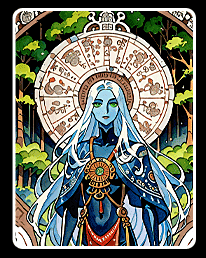 Whitecap Whitecap
The holiday called "Whitecap" is a combination costume party and treasure hunt
for children, based on a legend that arose out of the aftermath
of the atomic wars c.350 CE. In the legend, refugee children from
the nearby ruined city visited the treehouse of a forest hermit
(Whitecap) who refused to give them food but instead would allow
them to "steal" small tools and other helpful items. In the
holiday, children (usually of pre-diral age) dress in ghastly
costumes as refugees or corpses, and adults hide gifts wrapped
in seed-pods with red twine for the children to find. The gifts
are traditionally small but useful items such as fishhooks,
flint blades, glass vials, or coils of cord or wire, but they
may also include more expensive modern items or small treats of
dried food or hard candy. Households of more enthusiastic adults
prepare elaborate mazes complete with hidden antagonists
(usually older children or sometimes the adults themselves) to
spring out and chase the children through the maze. Captured
children are judged on the gruesomeness of their costumes, with
the best awarded treats of food.
Though the treasure-seeking activity is mostly for smaller
children, communities located near to the regular diral training
sites will sometimes leave Whitecap gifts for the child-bands
deployed nearby.
Mizol: The Left Hand
At the time of contact, the Mizol were Perrein's equivalent
of Deinar's Teidar, each culture's generic psionic warfare
specialist caste. With the introduction of psionic amplifiers,
psychokinetic abilities had begun to dominate Teidar techniques,
but meanwhile Perrein's Mizol had maintained comparable
effectiveness without amplification through their mastery of
advanced telepathic techniques. As the Loroi subcultures began
to integrate, both groups began to further specialize, with the
Mizol eventually absorbing Deinar's version of the diplomatic
caste and leaving the high-powered psychokinetic schools to the
Teidar. Today the Mizol are one of the empire-wide castes and
its headquarters (the Mizol Academy) is still on Perrein in the
city-state of Eishran.
Mizol have a wide range of responsibilities, including
diplomacy, foreign intelligence, military intelligence,
espionage, covert operations and some direct-action special
forces. Candidates are usually required to have strong basic
telepathic power and at least some psychokinetic ability. Mizol
are trained to use their psionic abilities without any
amplification, and are schooled in a variety of skills including
(unusually for Loroi warriors) spoken expression. In addition to
the diplomatic corps, Mizol are deployed with regular military
units to serve as a combination of intelligence officer,
political officer and internal affairs officer. The covert
operations section is a wing of the diplomatic corps, which
those in formal diplomatic contact with the Loroi are not always
thrilled about.
In accordance with duties that often involve subterfuge,
Mizol are trained in the arts of misdirection, concealment, and
outright falsehood. In the course of a covert action or internal
investigation, it is not unusual for a Mizol to assume another
identity or to wear the uniform of a different caste. As these
practices run directly contrary to the pervasive Loroi warrior
ethic of honesty and directness, the attitudes of the rest of
Loroi society to the Mizol can be described as mixed, at best.
Perrein's local government is run by a council of elders
chaired by an Imperial governor, but that council is closely
tied to the Mizol caste hierarchy. It is sometimes joked
that the capital of Perrein is actually the administrative
building of the Mizol Academy. (The Perrein Imperial Governor's
administration does not find this joke quite so funny.)
The Mizol Academy complex in Eishran is extensive, and includes
schools for a variety of specialty telepathic techniques,
including some for Teidar, Nedatan and other castes and orders
outside the Mizol. The various Perrein city-states practiced and
continued to practice different specialty techniques, and these
are incorporated into the various schools. These specialized schools
are offered both for "undergraduate" training
and for "postgraduate"
study in specific techniques.
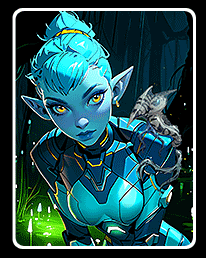 Reimadi:
The Beast Handlers Reimadi:
The Beast Handlers
Some Loroi telepaths can form especially strong connections
with non-Loroi organisms, and such individuals were instrumental in
the Perrein colony's early survival. The sori in particular were
very useful to be able to detect, understand, hunt and
eventually control (to some extent). The Sori Reimadi, as
they became called, collected and maintained the lore
of the forest and could even capture, keep and breed some of its species.
Due to their deep reservoir of wild genes, sori can never become
truly domesticated, but the Reimadi have bred strains of begisas
and beimish that are much less hazardous to Loroi than their
completely wild counterparts.
Loroi with similar "animal-speaking" abilities also existed
on Deinar and Taben, though the lack of complex land animals
beyond the Soira-liron livestock limited their utility. After
reunification and the subsequent colonization of new worlds with
more advanced native fauna, the Sori Reimadi model was extended
to these new worlds. The existing animal specialists were
absorbed together with the Sori Reimadi into a new sub-caste of
the Soroin (as the Sori Reimadi had
neither the administrative capacity nor interest in managing
chapters on distant worlds), but in practice it acts as an
independent
hybrid caste headquartered on Perrein, with unique uniforms and
practices. They are most associated
with begisas; these small sori can be made useful in several different life
stages for hunting, tracking, and detection of chemical and biological signatures.
Reimadi candidates must either possess stronger than average
telepathic abilities as regards non-Loroi subjects, or else Listel-like eidetic memory to help keep track of the deep
generational knowledge of the native organisms and their
behavior. A graduating Reimadi novice is commissioned Soroin
Reimadi and when attached as a specialist to a regular
Soroin infantry unit wears a variant of the green Soroin
uniform. Upon promotion to higher rank, the individual is
subsequently titled with Reimadi as the caste name (e.g.,
Reimadi Sain or Reimadi Rosair) and wears the more
distinctive blue-green Reimadi uniform.
The Sori Reimadi of Perrein have their own Listel-like female "rememberers"
or ninzadi (Reimadi Sain), but they also coordinate with male ninzadi of a
local male philosopher order, the Remirlaiet.
Remirlaiet: Keepers of the Shadow Lore
Prior to Deinar contact, the most influential order of male
philosophers on Perrein was the Remirlaiet. This order performed
most of the features of the Deinar Nedatan (keepers of
mythological lore and spiritual counselors), but also shouldered
a large part of the burden of working out and maintaining the
lore of the complex and dangerous native Perrein biosphere. The
Remirlaiet also had a larger than usual (for Loroi) role in
international politics, sometimes acting as a channel for
back-room diplomacy, and in some city-states, had jurisdiction
over allocating mating assignments.
Since reunification, the Nedatan order has surpassed the
Remirlaiet even in local influence, and has co-opted many of its
traditional functions. However, their role as assistants to the
Sori Reimadi is still an essential one.
Cuisine
Perrein is perhaps as famous (or "infamous") for its cuisine
as any other characteristic. Though Perrein's biosphere is a
plentiful source of foods, preparation and preservation present
significant challenges. To start with, nearly all Perrein flora
and fauna contain toxins, from toxic metals and acidic chemicals
to outright poison and venom. Second, plant and animal tissues
on Perrein begin to decompose rapidly after the organism's
death, thanks to the aggressive native fungi and bacteria. So any processing that is required to detoxify potential
food must accomplish its job in the short window before the food
spoils. Accordingly, the most common traditional food
preparation is some kind of pickle or brine, which can
simultaneously preserve food while neutralizing the toxins it
contains. More recently with higher technology, preservation by drying has
also become a common and
effective option for the modern Loroi, especially for foods such
as dogos that
have been bred for reduced toxicity.
Dried dogos and pickled dizo are the most common exports.
Semi-domesticated live dogos
is commonly grown in arboretums in space installations and is a staple
of military rations (whether this is appreciated by non-Perrein
troops or not), but dizo and other sori foods are consumed mainly by Perrein
expatriots. To the palates of many who are not Perrein natives, the
strong-smelling and -tasting pickles and brines used to preserve Perrein foods seem just as
unpleasant as the poison or rot that they were used to
counteract.
There is a small but profitable trade in fresh preparation of
wild Perrein foods, but many are cautious to patronize
restaurants in which there is the real possibility that the
ingredients may murder you. Some Perrein epicureans claim that
the delight of eating dogos so fresh that it is still
bioluminescent is worth the risk... but your mileage may vary.
See also:
Loroi,
Loroi
Timeline,
Loroi Sister Worlds
|
![]()
![]()
![]()
![]()




 Dogos
Dogos
 Lobei
Lobei The Sun-Worshippers
The Sun-Worshippers Perrein Culture
Perrein Culture Whitecap
Whitecap Reimadi:
The Beast Handlers
Reimadi:
The Beast Handlers